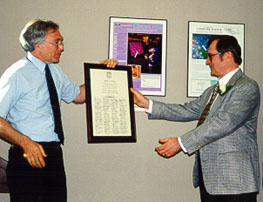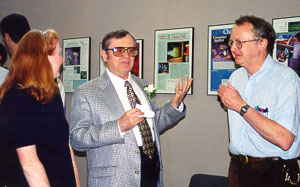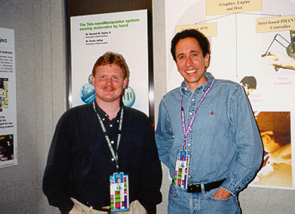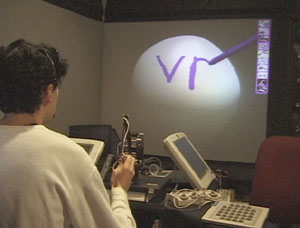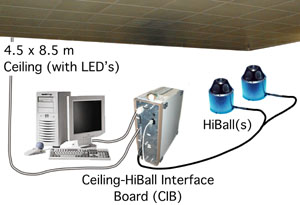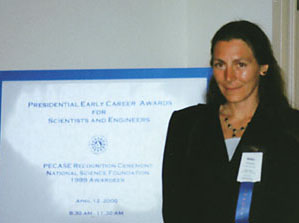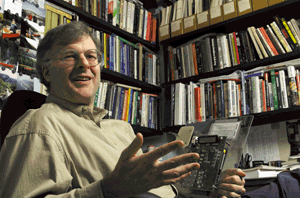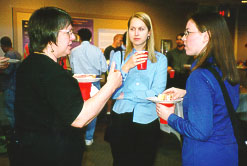Congratulations to...
Christopher D. Arrington, an undergraduate in the computer
science option of the Mathematical Sciences curriculum, who was initiated
into Phi Beta Kappa on 10 April.
Bil Hays, network manager, one of ten UNC-Chapel Hill
employees to receive an Individual Information Technology Award,
recognizing his outstanding contributions to information technology support
at UNC. He was presented with the award on 12 April at UNC's Information
Technology Support Awards Luncheon.
Brent Insko (M.S. 1998), Aditi Majumder (M.S. 1999),
and Voicu Popescu, graduate students, who have been awarded
Link fellowships for the 2000-2001 academic year.
Erin Parker, graduate student, who has been awarded a Computer
Science Ph.D. Fellowship from the Los Alamos Computer Science Institute,
beginning 1 September.
Karen Thigpen, formerly our receptionist, who was promoted in
February to the new position of Undergraduate Student Services Assistant.
Faculty
Promotions and Reappointments
Bert Dempsey, adjunct assistant professor, has been reappointed to
a three-year term, effective 1 July 2000.
Nick England, research professor, will become an adjunct research
professor, effective 1 July 2000.
Steven Molnar (Ph.D. 1991) has been promoted to adjunct
associate professor and reappointed for a three year term, effective 1
September 2000.
John Poulton has been reappointed as a research professor for a
five year term, effective 1 July 2000.
Russell M. Taylor II (Ph.D. 1994) has been promoted to research
associate professor and has been reappointed for a five year term, effective
15 May 2000. He has a joint appointment in the departments of Computer
Science and Physics and Astronomy, and in the Curriculum in Applied and
Materials Sciences. He is also the principal investigator of the new National
Institutes of Health Research Resource.
Leandra Vicci has been reappointed as lecturer for a five year term,
effective 1 July 2000.
Welcomes and Farewells
New Staff
Andrea Bunn, accounting technician, joined us in March. She has
been with UNC-Chapel Hill for about seven years. Prior to joining us, she
worked in the Department of Biochemistry. She is very excited about the
June graduation of her twin sons, Bryan and Brandon, from Chapel Hill
High School. They will attend N.C. State University and N.C. A&T State
University, respectively, in the fall.
Tammy Pike, receptionist, joined us in April. Previously, Tammy
worked in the main office of Contracts and Grants at UNC-Chapel Hill. She
has been with the University for a little over a year.
Visiting
Researchers
Joel Goossens, postdoctoral researcher, joins us from April to
June. He received his doctoral degree in January 1999 from the Universite
Libre de Bruxelles, Belgium. During his stay here, Joel is working with
Sanjoy Baruah, associate professor, on scheduling theory for real-time
systems.
Roger Hubbold, visiting scholar, joins us from May to November.
He is a senior lecturer and a member of the Advanced Interfaces Group in
the Department of Computer Science at the University of Manchester,
England. His research interests include virtual reality, novel 3D interfaces,
software architectures for distributed multi-user virtual reality, large model
processing, and interactive visualization using parallel computing systems.
While here, Roger is studying techniques for improving face-to-face,
collaborative interaction between participants in shared environments.
Leaves of
Absence
John G. Eyles, research associate professor, John Poulton,
research professor, and Stephen G. Tell (M.S. 1991), senior research
associate, each have been granted extensions to their off-campus assignments
at Chip2Chip, through 31 December 2000.
Stephen Brumback and Kurtis Keller, research
associates, are on off-campus assignments from April to August at 3rdTech,
Inc. (the new name for the Corporation for Development of Advanced
Technology, which we described in our Winter 1999-2000 issue).
Lars Nyland, research associate professor, has been granted an
extension to his part-time off-campus assignment, through 30 September
2000. He is working at 3rdTech, Inc.
Mary Whitton, research assistant professor, is on a part-time
off-campus assignment, working with the Institute for Development of
Advanced Technology, from mid-May to mid-July.
Thanks and Farewell to...
Arthur Gregory (B.S. MSci. 1997), research associate, who left in
May to pursue consulting opportunities. Most recently, Arthur worked on
the inTouch 3D modeling project. (arthurgregory@pobox.com)
Aron Helser (M.S. 1998), research associate, who left in May to
join 3rdTech, Inc., where he is part of a team working to develop the
nanoManipulator system into a commercial product.
The DiRT lab's networking infrastructure has significant remote access
capabilities, which allowed Mikkel and Gerardo to run all of their
experiments here at UNC, even after returning to Europe. Mikkel ran the
majority of his experiments remotely. One downside to the ease of access
became apparent last year, when hackers in Slovenia were able to find their
way into our Department's network, and then into the network at Duke, after
attacking the lab at Scuola Superiore in Pisa.
Upcoming Conferences
Several faculty and alumni are involved in planning upcoming conferences:
ACM Distributed Computing Symposium
James Anderson, associate professor, is the chair of the program
committee for the 19th Annual ACM Symposium on Principles of
Distributed Computing, which takes place in Portland, Ore., from 16-19 July
2000.
(http://www.podc.org/podc2000)
MICCAI 2000
Guido Gerig, Taylor Grandy professor, is co-organizing the Third
International Conference on Medical Robotics, Imaging, and Computer
Assisted Surgery (MICCAI 2000), to be held in Pittsburgh, Pa., from 11-14
October.
(http://www.miccai.org)
NOSSDAV 2000 and RTSS 2000
Kevin Jeffay, S. S. Jones associate professor, is co-chair of the
conference committee for the Tenth International Workshop on Network and
Operating Systems Support for Digital Audio and Video (NOSSDAV 2000),
to be held in Chapel Hill, N.C., from 26-28 June (http://www.cs.umass.
edu/~shenoy/nossdav). He is also chair of the program committee
for the 21st IEEE Real-Time Systems Symposium (RTSS 2000), which
takes place in Orlando, Fla., from 27-30 November.
(http://www.cs.unc.edu/rtss2000)
SIGGRAPH Eurographics Workshop
Anselmo Lastra, research associate professor, and Ulrich
Neumann (Ph.D. 1993) are co-chairing the papers committee for the
SIGGRAPH Eurographics Workshop 2000, to be held in Interlaken,
Switzerland from 20-21 August.
(http://www.merl.com/hwws00)
SIGGRAPH 2000
Several faculty and alumni are involved in planning SIGGRAPH 2000,
which takes place in New Orleans, La., from 23-28 July. Six of the
thirty-four members of the papers committee have direct ties to UNC-Chapel
Hill: Henry Fuchs, Federico Gil professor, Dinesh Manocha,
associate professor, and four alumni--David Banks (Ph.D. 1993) of
Florida State University, Andrew Glassner (Ph.D. 1988) of
Microsoft Research, Victoria Interrante (Ph.D. 1996) of the
University of Minnesota, and Marc Levoy (Ph.D. 1989) of
Stanford University. David, Dinesh, Marc, and Victoria will chair paper
sessions during the conference. Anselmo Lastra, research associate
professor, is chair of the courses committee. Several faculty and alumni are
making course presentations. Among the accepted papers are several from
faculty, students, and alumni. For a complete list, see
http://www.siggraph.org/s2000.
Recent Publications
Baruah, S., G. Buttazzo, S. Gorinsky, and G. Lipari. "Scheduling Periodic
Task Systems to Minimize Output Jitter," Proc. International Conference
on Real-Time Computing Systems and Applications, Hong Kong,
China, December 1999, 62-69.
Anderson, J., S. Baruah, and K. Jeffay. "Parallel Switching in
Connection-Oriented Networks," Proc. 20th IEEE Real-Time Systems Symposium,
Phoenix, Ariz., December 1999, 200-209.
Clark, M., and K. Jeffay. "Application-Level Measurements of Performance
on the vBNS," Proc. IEEE International Conference on Multimedia
Computing and Systems, Vol. 2, Florence, Italy, June 1999, 362-366.
Gerig, G., D. Welti, C. Guttmann, A. Colchester, and G. Szekely.
"Exploring the Discrimination Power of the Time Domain for Segmentation
and Characterization of Lesions in Serial MR Data," Medical Image
Analysis, 4(1), 2000.
Gerig, G., D. Welti, G. Szekely, E. W. Radue, and L. Kappos.
"Quantification of MS Lesion Evolution in a Serial MRI Study," Proc.
15th Congress of the European Committee for Treatment and Research in
Multiple Sclerosis, Spring 2000.
Goddard, S. M., and K. Jeffay. "Analyzing the Real-Time Properties of a
U.S. Navy Signal Processing System," Proc. Fourth IEEE International
Symposium on High Assurance Systems Engineering, Washington,
D.C., November 1999, 141-150.
Gopi, M., and D. Manocha. "Simplifying Spline Models,"
Computational Geometry: Theory and Applications, Vol. 14, 1999,
67-90.
Gregory, A., S. Ehmann, and M. Lin. "inTouch: Interactive Multiresolution
Modeling and 3D Painting with a Haptic Interface," Proc. IEEE Virtual
Reality Conference, March 2000, 45-52.
Gregory, A., M. Lin, S. Gottschalk, and R. Taylor. "Real-Time Collision
Detection for Haptic Interaction Using a 3-DoF Force Feedback Device,"
Computational Geometry: Theory and Applications (special issue on
virtual environments), 15(1-3), February 2000, 69-89.
Gregory, A., A. State, M. C. Lin, D. Manocha, and M. Livingston.
"Interactive Surface Decomposition for Polyhedral Morphing," Visual
Computer, Vol. 15, 1999, 453-470.
Guthold, M., M. Falvo, W. G. Matthews, S. Paulson, A. Negishi, S.
Washburn, R. Superfine, F. P. Brooks Jr., and R. M. Taylor II.
"Investigation and Modification of Molecular Structures Using the
NanoManipulator," Journal of Molecular Graphics and Modeling,
Vol. 17, October 1999, 187-197.
Hoff, K., T. Culver, J. Keyser, M. Lin, and D. Manocha. "Interactive Motion
Planning Using Hardware Accelerated Computation of Generalized Voronoi
Diagrams," Proc. IEEE International Conference on Robotics and
Automation, 2000, 2931-2937.
Jeffay, K. "Towards a Better-Than-Best-Effort Forwarding Service for
Multimedia Flows," IEEE Multimedia, 6(4), October-December
1999, 84-88.
Jeffay, K., and S. M. Goddard. "A Theory of Rate-Based Execution,"
Proc. 20th IEEE Real-Time Systems Symposium, Phoenix, Ariz.,
December 1999, 304-314.
Kelemen, A., G. Szekely, and G. Gerig. "Elastic Model-Based Segmentation
of 3-D Neuroradiological Data Sets," IEEE Transactions on Medical
Imaging, 18(10), October 1999, 828-839.
Larsen, E., S. Gottschalk, M. Lin, and D. Manocha. "Fast Distance Queries
Using Rectangular Swept Sphere Volumes," Proc. IEEE International
Conference on Robotics and Automation, 2000, 3719-3726.
Lin, M. C. "Fast Proximity Queries for Large Game Environments,"
Proc. Computer Game Developers Conference, March 2000.
Pisula, C., K. Hoff, M. Lin, and D. Manocha. "Randomized Path Planning
for a Rigid Body Based on Hardware Accelerated Voronoi Sampling,"
Proc. Fourth International Workshop on Algorithmic Foundations of
Robotics, 2000, SA31-SA44.
Plaisted, D. A. "Special Cases and Substitutes for Rigid E-Unification,"
Applicable Algebra in Engineering, Communication and Computing,
10(2), 2000, 97-152.
Prins, J., S. Chatterjee, and M. Simons. "Irregular Computations in
Fortran--Expression and Implementation Strategies," Scientific Programming,
Vol. 7, 1999, 313-326.
Prins, J., J. Hermans, G. Mann, L. Nyland, and M. Simons. "A Virtual
Environment for Steered Molecular Dynamics," Future Generation
Computer Systems, Vol. 15, 1999, 485-495.
Raskar, R. "Immersive Planar Displays Using Roughly Aligned Projectors,"
Proc. IEEE VR 2000, New Brunswick, N.J., 18-22 March 2000.
Alumni News
M.S. and
Ph.D. Alumni
Ron Azuma (Ph.D. 1995) and fellow alumnus Ulrich
Neumann (Ph.D. 1993) were among the authors on a recent paper:
Azuma, R., J. W. Lee, B. Jiang, J. Park, S. You, and U. Neumann, "Tracking
in Unprepared Environments for Augmented Reality Systems,"
Computers and Graphics, 23(6), December 1999, 787-793.
(azuma@HRL.com)
Steven Bellovin (Ph.D. 1982) was quoted in several recent
publications, including Business Week, Newsweek, The New York
Times, and The Wall Street Journal, concerning breaches in
Internet security and cell phone viruses. Steven, a researcher at AT&T Bell
Labs, is an expert on Internet security issues. (smb@research.att.com)
Edoardo Biagioni (Ph.D. 1992) recently received the grant, "A
Remote Ecological Micro-Sensor Network," from the Defense Advanced
Research Projects Agency. He is an assistant professor in the Department of
Information and Computer Science at the University of Hawaii at Manoa.
(esb@hawaii.edu)
Michael Capps (M.S. 1996) defended his Ph.D. dissertation,
"Fidelity Optimization in Distributed Virtual Environments," in June.
Michael, a research assistant professor at the Naval Postgraduate School in
Monterey, Calif., is organizing the course "Developing Shared Virtual
Environments," again at this year's SIGGRAPH. He is a co-author on a
paper for Eurographics 2000 to be held in Interlaken, Switzerland, in
August: "Collaboration Between Heterogeneous Stand-Alone 3-D Graphical
Applications." Michael is the workshops chair for VR 2001 to be held in
Tokyo, Japan, next March, and is program chair for the Web3D 2001
conference to be held in Paderborn, Germany, next February.
(capps@acm.org)
Matthew Cutts (M.S. 1998) recently joined Google, Inc., a search
engine company located in Mountain View, Calif. (matt@google.com)
Ransom Murphy (M.S. 1993) has been working at Lucent
Technologies in Cary, N.C., for the past six years as a systems architect for
wireless application development. (gmurphy@lucent.com)
Karl Owen (M.S. 1992) was recently promoted to the position of
staff specialist at EMC Corp. in Research Triangle Park, N.C. He works in
the CLARiiON division, where he develops advanced storage devices. Karl
lives in Chapel Hill with his wife, Susan Buchanan, and their daughter,
Jordan, aged two. They expect a second child in June.
(karl.owen@kmodem.org)
Jason Priebe (M.S. 1996) is the technical director of WRAL
OnLine (http://www.wral-tv.com).
In December, the National Association of Television
Programming Executives awarded WRAL OnLine the prestigious Iris
Award for the best web site by a television station.
(priebe@wral-tv.com)
Raymond Van Dyke (M.S. 1989), an e-commerce lawyer at the
firm of Jenkens & Gilchrist, P.C., in Dallas, Texas, was quoted in the March
issue of MIT's Technology Review on software patent issues, and in the
March issue of the National Law Journal on e-commerce and Internet viral
patenting problems. Raymond has been busy speaking on e-commerce and
related topics. This spring, he spoke to students and visitors at Southern
Methodist University's Computer Engineering Department on software and
business method patenting issues and e-commerce. In June, he spoke about
business method patenting issues at the 17th Annual Pacific Rim Computer
Law Institute in Seattle, Wash. In July, he will give presentations on
copyright ownership at Bar Association meetings in Dallas and Houston.
(vandyke@acm.org, vandyke@jenkens.com)
Amitabh Varshney (Ph.D. 1994) will join the University of
Maryland faculty as an associate professor this fall. He and his wife,
Poonam, are relocating to the College Park area in June. Since receiving his
Ph.D., Amitabh has been on the faculty at SUNY Stony Brook in Stony
Brook, N.Y. (varshney@cs.umd.edu)
John Q. Walker II (Ph.D. 1991) was one of four co-founders of
Ganymede Software, which became part of NetIQ Corp. through a series of
mergers and acquisitions this spring. Ganymede is a leading provider of
end-to-end network performance management software. Its development offices
remain in Morrisville, N.C. Ganymede joins Mission Critical Software of
Houston, Texas, Sirana Software of Bellevue, Wash., and the original NetIQ
Corp. of Santa Clara, Calif. The new NetIQ, a public company, provides
comprehensive, leading-edge solutions for managing eBusiness
infrastructures and Windows NT- and Windows 2000-based systems and
applications. (johnq@netiq.com)
Undergraduate
Alumni
Howard Gross (B.S. MSci. 1984) has been the executive director
of HawkWatch International since June 1999 (www.hawkwatch.org).
Headquartered in Salt Lake City, Utah, HawkWatch's mission is to protect
hawks, eagles, and other birds of prey through research, education, and
conservation. It operates research projects in eight western states, Florida,
and Mexico. Howard reports that he thoroughly enjoys the job.
(hgross@hawkwatch.org)
Former Faculty
News
John McHugh, former research associate professor, is the general
chair for the Fourth International Information Hiding Workshop, to be held
in Pittsburgh, Pa., next April
(http://chacs.nrl.navy.mil/IHW2001). He has a
recent paper, "Chaffing at the Bit: Thoughts on a Note by Ron Rivest,"
Proc. 1999 Information Hiding Workshop, Dresden, Germany.
Lecture Notes in Computer Science #1798, Springer-Verlag, 1999,
395-404. John is on the Computer Emergency Response Team at the Software
Engineering Institute in Pittsburgh, Pa. (jmchugh@cert.org)
Award-Winning
Alumni
Presidential Early Career Award
Victoria Interrante (Ph.D. 1996) is one of 20 researchers supported
by the National Science Foundation (NSF) to receive the 1999 Presidential
Early Career Award for Scientists and Engineers (PECASE). She attended
the awards ceremony at the White House Old Executive Office Building on
12 April where Neal Lane, the President's science advisor
presented the awards (for more information, see NSF's press release at
http://www.nsf.gov/od/lpa/news/press/00/pr0022.htm). Victoria
was cited for her innovative contributions to research and education in
combining graphics, visualization, and cognitive science to develop a
science of representation for the design of computer interfaces. The
PECASE award is the highest honor bestowed by the U.S. government on
outstanding new scientists and engineers in the early stages of establishing
their independent research careers. NSF selects its PECASE nominees from
among its most meritorious CAREER (Faculty Early Career Development)
awardees. The CAREER award supports exceptionally promising college
and university junior faculty committed to the integration of research and
education. Victoria received a CAREER award in 1999. Currently, she is an
assistant professor in the Department of Computer Science and Engineering
at the University of Minnesota. (interran@cs.umn.edu)
UNC is an Equal Opportunity/Affirmative Action Institution.
